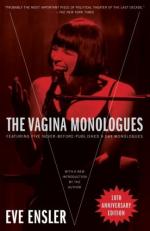|
This section contains 619 words (approx. 2 pages at 400 words per page) |

|
The Vagina Monologues Summary & Study Guide Description
The Vagina Monologues Summary & Study Guide includes comprehensive information and analysis to help you understand the book. This study guide contains the following sections:
This detailed literature summary also contains Topics for Discussion and a Free Quiz on The Vagina Monologues by Eve Ensler.
This book is an expansion of a play originally written and performed in 1998, with both book and play anchored by the author's intent to break down the barriers of secrecy and shame surrounding both the use of the word "vagina" (both in public and in private) and the violence perpetrated against those who have one. Drawing upon both personal experiences and those of women whom she interviewed as source material, the author creates a wide-reaching, multi-faceted portrait of both the positive and negative aspects of being a woman in contemporary society.
The book opens with a series of introductions. The first is by the author, introducing the book as a central component of the Tenth Anniversary celebration of the creation, publication, and performance of her original play. She describes how her original intention (to simultaneously celebrate womanhood and awaken awareness of violence against women) has expanded into a worldwide movement manifesting the same dual intention. Introductions to the original published edition of the play (by noted feminist Gloria Steinem and by the author) highlight the need for such a movement, and the value it has in women's individual lives and in the place women have, can take, or in some cases are forced, in society.
The main body of the book consists of the original Vagina Monologues as well as subsequently written material. At the outset, the author comments that the content of the monologues is, for the most part, based on interviews she conducted with a number of women, material she distilled and shaped to varying degrees. Some of the monologues, she writes, are practically verbatim transcripts of what she was told. Others, she adds, are compilations and/or summaries.
The subjects of the monologues vary widely - from a serio-comic consideration of pubic hair to an elderly woman's description of her lifelong perceptions of and/or experiences with her vagina to a young girl's responses to the standard questions the author asks in her interviews. These questions range from "If your vagina got dressed, what would it wear?" to "If it could speak, what would it say?" to "What does your vagina smell like?" Summaries of answers to all three of these questions make up three of the monologues.
Many of the monologues are introduced and/or commented on by the author. Several times, she suggests that as she continued her interviews and gathered more and more vagina-related experiences, she made realizations about her own perspectives and attitudes. At one point, for example, she describes her realization that in the original play, she had not included any discussions about birth, and then includes a monologue communicating her sense of wonder at being present for the birth of her grand-daughter. At another point, she incorporates her discomfort with a discussion of lesbian sexuality into a monologue spoken by a sexually satisfied lesbian prostitute.
This section also includes several monologues inspired by, and incorporating, the experiences of women from around the world. A section entitled "The Spotlight Monologues" contains stories distilled from the experiences of, among others, Bosnian, Mexican, Pakistani, and Japanese women. This international broadening of perspective echoes, and perhaps is a manifestation of, a broadening of the author's personal perspective.
The final section of the book is a summary/documentation of the way the author's original intention has evolved into the world wide movement known as V-Day, a social activism aimed at increasing awareness of the pervasiveness of violence against women and ending such violence for good. This section includes a year-by-year summary of activities in North America and around the world, and lists ways in which lives of both individuals and communities have been changed by alignment with V-Day's objectives and actions.
Read more from the Study Guide
|
This section contains 619 words (approx. 2 pages at 400 words per page) |

|



